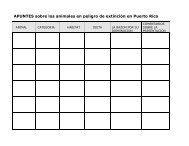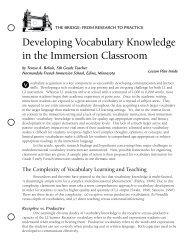Interpreting the Message of a Song - The Center for Advanced ...
Interpreting the Message of a Song - The Center for Advanced ...
Interpreting the Message of a Song - The Center for Advanced ...
You also want an ePaper? Increase the reach of your titles
YUMPU automatically turns print PDFs into web optimized ePapers that Google loves.
NOTESPre-listening/reading:<strong>The</strong> teacher displays <strong>the</strong> following questions on <strong>the</strong> overhead and plays <strong>the</strong>song two to three times. Students listen to <strong>the</strong> song without <strong>the</strong> text and in“home groups” <strong>of</strong> three briefly address <strong>the</strong> questions in English:• Can your group identify ten words in this song?• What does your group notice or find interesting about <strong>the</strong> song (i.e.,instruments used, rhythm, traditional vs. modern sounds)?• What might be a possible title <strong>for</strong> this song?Groups <strong>the</strong>n share <strong>the</strong>ir responses with <strong>the</strong> whole class.Next, <strong>the</strong> teacher distributes song lyrics in <strong>the</strong> target language and displays<strong>the</strong> title <strong>of</strong> <strong>the</strong> song on an overhead projector. <strong>The</strong> teacher briefly reviewscultural context as necessary to enhance comprehension. A few keyvocabulary expressions and language structures that may present difficulties<strong>for</strong> students are <strong>the</strong>n discussed. For example, <strong>the</strong> song lends itself to a focus on <strong>the</strong> <strong>for</strong>mation and use <strong>of</strong> infinitives with <strong>the</strong>verb querer and gerunds.While looking at <strong>the</strong> song first individually, and <strong>the</strong>n in pairs, studentscircle and identify key language structures (querer + infinitive and gerunds)and vocabulary and <strong>the</strong>n check with a partner to ensure that each <strong>of</strong> <strong>the</strong>munderstands <strong>the</strong>ir meaning and use.Jigsaw Reading Activity:For this jigsaw task (Kagan, 1989, cited in Shrum & Glisan, 1994), students<strong>for</strong>m “home groups” having three members each. In <strong>the</strong>se “home groups,”students decide who will assume <strong>the</strong> following roles:• reader/checker <strong>of</strong> understanding (initially reads <strong>the</strong> song aloud too<strong>the</strong>rs and checks <strong>for</strong> group members’ understanding during postreadingbase group activities)• reporter (reports <strong>the</strong> group’s interpretation to <strong>the</strong> whole class)• recorder (takes notes on task instructions and group’s discussion)First, <strong>the</strong> reader reads <strong>the</strong> refrain aloud to o<strong>the</strong>rs as o<strong>the</strong>rs read silently to<strong>the</strong>mselves. Students are asked to focus on a general understanding <strong>of</strong> <strong>the</strong>gist or meaning <strong>of</strong> <strong>the</strong> song. During “home group” work, students answer<strong>the</strong> following questions displayed on <strong>the</strong> overhead:p.418 <strong>Interpreting</strong> <strong>the</strong> <strong>Message</strong> <strong>of</strong> a <strong>Song</strong>© 2006, Regents <strong>of</strong> <strong>the</strong> University <strong>of</strong> Minnesota. See final page <strong>for</strong> full copyright in<strong>for</strong>mation.
NOTES• What kind <strong>of</strong> person may have written this song? Why do you thinkso?• For whom might this song have been written? Describe this person.• How do you think <strong>the</strong> songwriter is feeling?• Where might this situation take place?• What might be <strong>the</strong> message intended by <strong>the</strong> songwriter?• What images/metaphors does <strong>the</strong> songwriter use to communicatehis/her message/feelings?“Home group” members <strong>the</strong>n regroup <strong>the</strong>mselves in three medium-sizedgroups according to assigned roles. In <strong>the</strong>se newly <strong>for</strong>med “expert groups,”each group is asked to decipher <strong>the</strong> meaning <strong>of</strong> one <strong>of</strong> <strong>the</strong> four-line stanzas.Each member <strong>of</strong> <strong>the</strong> group writes a 2-3 sentence summary in <strong>the</strong> targetlanguage paraphrasing <strong>the</strong>ir section (<strong>the</strong>y should be discouraged fromlifting phrases straight from <strong>the</strong> song). Some English may be spoken at thispoint to discuss and clarify meaning. Once <strong>the</strong> “expert groups” have hadample time to analyze <strong>the</strong>ir section <strong>of</strong> <strong>the</strong> song, <strong>the</strong>y will return to <strong>the</strong>iroriginal “home groups.”While <strong>the</strong> students are working in expert groups and home groups, <strong>the</strong>teacher circulates to answer students’ questions and help guide <strong>the</strong>m in<strong>the</strong>ir comprehension and interpretation.Post-reading:In “home groups,” each member takes a turn sharing <strong>the</strong>ir summary <strong>of</strong><strong>the</strong>ir part <strong>of</strong> <strong>the</strong> song with <strong>the</strong> o<strong>the</strong>r group members. Again, some Englishmay be spoken at this point to discuss and clarify meaning. By <strong>the</strong> end<strong>of</strong> this stage, groups should have a good understanding <strong>of</strong> <strong>the</strong> meaning<strong>of</strong> <strong>the</strong> song’s lyrics and should be ready to return to a discussion <strong>of</strong> <strong>the</strong>songwriter’s message.As students attempt to interpret <strong>the</strong> message(s) <strong>the</strong>y think <strong>the</strong> songwriterwishes to convey, <strong>the</strong> teacher will emphasize that because this isinterpretation, <strong>the</strong>re is no right or wrong anwer. However, <strong>the</strong> groupshould be able to back up <strong>the</strong>ir interpretation with specific references to <strong>the</strong>song’s lyrics. Each group ultimately creates a 1-3 sentence summary <strong>of</strong> <strong>the</strong>songwriter’s intended message(s). <strong>The</strong> recorder writes down this summary.Critical Explorations p.419© 2006, Regents <strong>of</strong> <strong>the</strong> University <strong>of</strong> Minnesota. See final page <strong>for</strong> full copyright in<strong>for</strong>mation.
NOTES<strong>The</strong> base group reporter <strong>for</strong> each base group shares <strong>the</strong>ir interpretation <strong>of</strong><strong>the</strong> song with <strong>the</strong> whole class. <strong>The</strong>y should be able to explain on what lyrics<strong>the</strong>ir interpretation is based. After <strong>the</strong> reporters presentations, <strong>the</strong> teachercan guide <strong>the</strong> class in a summary discussion, comparing and contrasting <strong>the</strong>various interpretations.Finally, in “home groups” students reflect on <strong>the</strong> group process and discusshow well <strong>the</strong>y included <strong>the</strong> above-stated social skills while working ingroups.Assessment:First, students will demonstrate understanding <strong>of</strong> <strong>the</strong>ir section <strong>of</strong> <strong>the</strong>song by being able to paraphrase and explain its meaning to <strong>the</strong>ir groupmembers. In addition, each “home group’s” written summary interpretation<strong>of</strong> <strong>the</strong> song’s message will be handed in and assessed with a primary traitrubric <strong>for</strong> understanding <strong>of</strong> intended message with appropriate reference tospecific lyrics to back up <strong>the</strong> interpretation (see rubric provided).Finally, <strong>the</strong> students will address in writing <strong>the</strong>ir assessment <strong>of</strong> <strong>the</strong>ir ownparticipation and use <strong>of</strong> social skills in <strong>the</strong> “home group.” Each groupmember will <strong>of</strong>fer one future recommendation <strong>for</strong> more effective groupwork.Extensions:Suggestions <strong>for</strong> adapting <strong>the</strong> task <strong>for</strong> various levels:For beginning levels: Students can limit <strong>the</strong>mselves to a focus on <strong>the</strong> refrainonly.For advanced levels:• All discussion <strong>of</strong> meaning can be done in <strong>the</strong> target language.• Instead <strong>of</strong> doing a jigsaw comprehension/interpretation activity <strong>for</strong> justone song, each expert group can have a different song to analyze abouta related topic. Members <strong>the</strong>n go back to <strong>the</strong>ir base groups and explainwhat <strong>the</strong>ir song has to say about this topic to <strong>the</strong> o<strong>the</strong>r group members.p.420 <strong>Interpreting</strong> <strong>the</strong> <strong>Message</strong> <strong>of</strong> a <strong>Song</strong>© 2006, Regents <strong>of</strong> <strong>the</strong> University <strong>of</strong> Minnesota. See final page <strong>for</strong> full copyright in<strong>for</strong>mation.
yrics L to esca on album o ser entitled <strong>the</strong> agua song fr have been eprinted r with permission.Singer: José Luís PeralesJohnson, D., Johnson, R., & Holubec, E. (1993). Cooperation in <strong>the</strong>classroom. Edina, MN: Interaction Book Company.Kagan, S. (1989). Cooperative learning: Resources <strong>for</strong> teachers. San JuanCapistrano, CA: Resources <strong>for</strong> Teachers.Shrum, J., & Glisan, E. (1994). Teacher’s handbook: Contextualized languageinstruction. Boston, MA: Heinle and Heinle Publishers.Critical Explorations p.421© 2006, Regents <strong>of</strong> <strong>the</strong> University <strong>of</strong> Minnesota. See final page <strong>for</strong> full copyright in<strong>for</strong>mation.
Reflections:p.422 <strong>Interpreting</strong> <strong>the</strong> <strong>Message</strong> <strong>of</strong> a <strong>Song</strong>© 2006, Regents <strong>of</strong> <strong>the</strong> University <strong>of</strong> Minnesota. See final page <strong>for</strong> full copyright in<strong>for</strong>mation.
© 2006, Regents <strong>of</strong> <strong>the</strong> University <strong>of</strong> Minnesota. <strong>The</strong>se materials were created by members <strong>of</strong> <strong>the</strong> Minnesota Articulation Project and were edited by Diane J.Tedick. Permission is granted to duplicate <strong>the</strong>se materials <strong>for</strong> educational purposes. Permission to reprint must be sought from <strong>the</strong> <strong>Center</strong> <strong>for</strong> <strong>Advanced</strong>Research on Language Acquisition.Originally published in Tedick, D.J. (Ed.). (2002). Pr<strong>of</strong>iciency-oriented language instruction and assessment: A curriculum handbook <strong>for</strong> teachers. CARLAWorking Paper Series. Minneapolis, MN: University <strong>of</strong> Minnesota, <strong>The</strong> <strong>Center</strong> <strong>for</strong> <strong>Advanced</strong> Research on Language Acquisition.
















